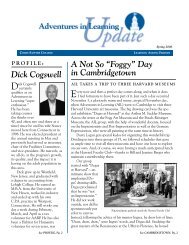A L U M N I M A G A Z I N E - Colby-Sawyer College
A L U M N I M A G A Z I N E - Colby-Sawyer College
A L U M N I M A G A Z I N E - Colby-Sawyer College
You also want an ePaper? Increase the reach of your titles
YUMPU automatically turns print PDFs into web optimized ePapers that Google loves.
crime-solving tools, and the one that has changed the face<br />
of crime detection almost as much as fingerprints did, is the<br />
Capillary Electrophoresis Genetic Analyzer. This powerful tool<br />
is more simply called the DNA typing instrument, and it can<br />
deliver a DNA profile from a sample as small as 50 to 100 cells,<br />
which is about the size of the period at the end of this sentence.<br />
While the tools for solving crimes have come a long way<br />
technologically, one tool has stayed the same, and Kim feels it<br />
may be the most important of all. “The crime scene investigator<br />
is close to the ultimate tool because the more you see, the<br />
more experienced you become, the more valuable you become.<br />
If you can get to the point where you can think outside the<br />
box, you’ve made a breakthrough. The instruments and tools<br />
we use can’t think outside the box…yet, so the trained criminalist<br />
is currently the ultimate weapon in solving crimes.”<br />
With a CSI as dedicated as Kim, the bad guys better beware.<br />
Kim is asked to testify in court about four or five times a<br />
year, and is more often asked to give depositions. While she<br />
does not particularly enjoy testifying in court, she says the<br />
upside is that you have a chance to interact with the jury.<br />
“With so many CSI shows on TV,” she explains, “juries seem<br />
to understand much more of what we explain in court. For<br />
example, if we use the terms Leuco Crystal Violet (LCV) or<br />
luminol, they know what those are.* In the old days we’d have<br />
to spend time explaining those chemicals and what they’re<br />
used for. The downside of the CSI programs is that juries think<br />
you can get DNA off anything and everything, and that DNA<br />
can solve any crime. The CSI shows are accurate for the most<br />
part, but there are things they depict that sometimes make us<br />
laugh down at the lab.<br />
“The worst pitfall in court,” Kim says with just a hint of<br />
agitation, “is when you get what I call ‘a mean attorney’ who<br />
may show you a book you’ve never seen before and ask if<br />
you’ve read it. When you say no, he jumps right on it and asks<br />
why you haven’t read it and proposes that it’s essentially the<br />
bible for your field of science. Then, even if you say, ‘No, that’s<br />
a pathology book,’ he still may have discredited you a little bit<br />
with the jury.”<br />
Kim has seen difficult sights, smelled terrible smells, and<br />
has, at the least, brushed shoulders with the worst in human<br />
*When Leuco Crystal Violet (LCV) and hydrogen peroxide come into contact with the hemoglobin in blood, a catalytic reaction occurs and the solution turns to<br />
a purple/violet color. Luminol is a versatile chemical that exhibits chemiluminesence with a striking blue glow when mixed with an appropriate oxidizing agent.<br />
Both are used at crime scenes, but LCV is easier to photograph, as it does not require a fully darkened room, whereas luminol does.<br />
Kim uses tweezers and an alternate light source to collect fibers from a pair<br />
of blue jeans.<br />
20 COLBY-SAWYER ALUMNI MAGAZINE<br />
The FTIR microscope is used when examining fibers for chemical composition.









